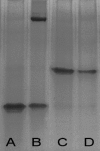High-affinity, human antibody-like antibody fragment (single-chain variable fragment) neutralizing the lethal factor (LF) of Bacillus anthracis by inhibiting protective antigen-LF complex formation
- PMID: 17517846
- PMCID: PMC1932538
- DOI: 10.1128/AAC.01528-06
High-affinity, human antibody-like antibody fragment (single-chain variable fragment) neutralizing the lethal factor (LF) of Bacillus anthracis by inhibiting protective antigen-LF complex formation
Abstract
The anthrax lethal toxin (LT) consists of two subunits, the protective antigen (PA) and the lethal factor (LF), and is essential for anthrax pathogenesis. Several recombinant antibodies directed against PA and intended for medical use have been obtained, but none against LF, despite the recommendations of anthrax experts. Here we describe an anti-LF single-chain variable fragment (scFv) that originated from an immunized macaque (Macaca fascicularis) and was obtained by phage display. Panning of the library of 1.8 x 10(8) clones allowed the isolation of 2LF, a high-affinity (equilibrium dissociation constant, 1.02 nM) scFv, which is highly neutralizing in the standardized in vitro assay (50% inhibitory concentration, 1.20 +/- 0.06 nM) and in an in vivo assay. The scFv neutralizes anthrax LT by inhibiting the formation of the LF-PA complex. The genes encoding 2LF are very similar to those of human immunoglobulin germ line genes, sharing substantial (84.2%) identity with their most similar, germinally encoded counterparts; this feature favors medical applications. These results, and others formerly published, demonstrate that our approach can generate antibody fragments suitable for prophylaxis and therapeutics.
Figures



References
-
- Andris-Widhopf, J., C. Rader, P. Steinberger, R. Fuller, and C. F. Barbas III. 2000. Methods for the generation of chicken monoclonal antibody fragments by phage display. J. Immunol. Methods 242:159-181. - PubMed
-
- Athamna, A., M. Athamna, N. Abu-Rashed, B. Medlej, D. J. Bast, and E. Rubinstein. 2004. Selection of Bacillus anthracis isolates resistant to antibiotics. J. Antimicrob. Chemother. 54:424-428. - PubMed
-
- Baillie, L., and T. D. Read. 2001. Bacillus anthracis, a bug with attitude! Curr. Opin. Microbiol. 4:78-81. - PubMed
-
- Baillie, L., S. Leppla, C. Quinn, P. Swann, F. Top, and S. Welkos. 2003. Expert consultation on monoclonal antibodies for anthrax rPA. http://www3.niaid.nih.gov/biodefense/research/products.htm#5.
-
- Baillie, L. W. 2006. Past, imminent and future human medical countermeasures for anthrax. J. Appl. Microbiol. 101:594-606. - PubMed
Publication types
MeSH terms
Substances
Associated data
- Actions
- Actions
LinkOut - more resources
Full Text Sources
Other Literature Sources

